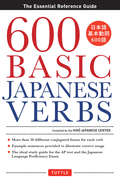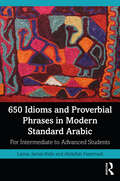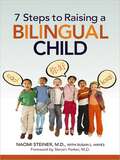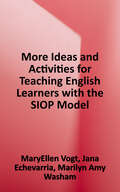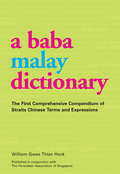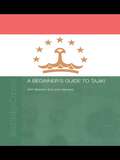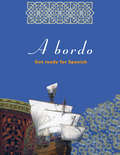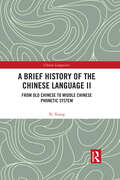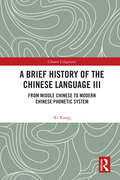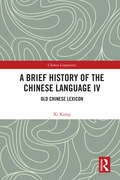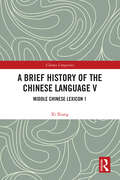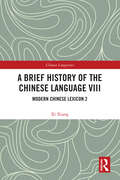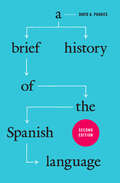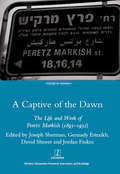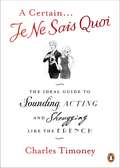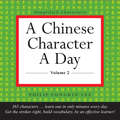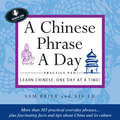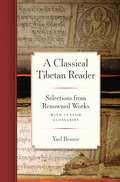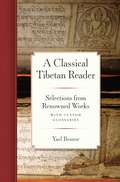- Table View
- List View
600 Basic Japanese Verbs
by Hiro Japanese Center600 Basic Japanese Verbs is a handy, easy-to-use guide to one of the building blocks of Japanese grammar-verbs.This book will be an essential resource as it shows learners how to conjugate the 600 most common Japanese verbs quickly, and with very little effort. This is the only guide to list all verb forms in both Japanese script and romanized form, while giving an accurate English translation for each conjugated form, making this book far more comprehensive than any other book on the subject.Key features of this book are: Includes all the most useful verbs and Kanji (logographic Chinese characters) in Japanese, including less common ones A wealth of example sentences are given to demonstrate correct verb usage Over 30 forms are given for each verb including polite or formal, plain, negative, potential, conditional, passive, causative, and many more Both Kana, Japanese script, and romanized forms are given for each entry An ideal study guide for the standard Advanced Placement college test and the Japanese Language Proficiency Exam Special sections are devoted to compound verbs and suru verbs such as Kaimono suru (to shop), benkyo suru (to study), and much more
600 Basic Japanese Verbs
by Hiro Japanese Center600 Basic Japanese Verbs is a handy, easy-to-use guide to one of the building blocks of Japanese grammar--verbs.This book will be an essential resource for students wishing to learn Japanese as it shows how to conjugate the 600 most common Japanese verbs quickly, and with very little effort. This is the only guide to list all verb forms in both Japanese script and romanized form.Compiled by Japanese language experts at The Hiro Japanese Center, more than 30 different verbal forms are given for each verb including all forms used in contemporary spoken, written, formal and conversational Japanese.Key features of this book are: Includes all the most useful verbs and Kanji (logographic Chinese characters) in Japanese, including less common ones. A wealth of example sentences are given to demonstrate correct verb usage. Over 30 forms are given for each verb including polite or formal, plain, negative, potential, conditional, passive, causative, and many more. Both Kana, Japanese script, and romanized forms are given for each entry. An ideal study guide for the standard Advanced Placement college test and the Japanese Language Proficiency Exam. Special sections are devoted to compound verbs and suru verbs such as Kaimono suru (to shop).
600 Basic Japanese Verbs: The Essential Reference Guide
by Hiro Japanese Center600 Basic Japanese Verbs is a handy, easy-to-use guide to one of the building blocks of Japanese grammar--verbs.This book will be an essential resource for students wishing to learn Japanese as it shows how to conjugate the 600 most common Japanese verbs quickly, and with very little effort. This is the only guide to list all verb forms in both Japanese script and romanized form.Compiled by Japanese language experts at The Hiro Japanese Center, more than 30 different verbal forms are given for each verb including all forms used in contemporary spoken, written, formal and conversational Japanese.Key features of this book are: Includes all the most useful verbs and Kanji (logographic Chinese characters) in Japanese, including less common ones. A wealth of example sentences are given to demonstrate correct verb usage. Over 30 forms are given for each verb including polite or formal, plain, negative, potential, conditional, passive, causative, and many more. Both Kana, Japanese script, and romanized forms are given for each entry. An ideal study guide for the standard Advanced Placement college test and the Japanese Language Proficiency Exam. Special sections are devoted to compound verbs and suru verbs such as Kaimono suru (to shop).
650 Idioms and Proverbial Phrases in Modern Standard Arabic: For Intermediate to Advanced Students
by Lamia Jamal-Aldin Abdullah Hammadi650 Idioms and Proverbial Phrases in Modern Standard Arabic is the ideal tool for learners of Arabic who wish to improve their knowledge and comprehension of Arabic language and culture and make their language more expressive and idiomatic. Including over 650 idiomatic expressions found in contemporary Arabic, this book is divided into two parts. Part I lists the idioms alphabetically for ease of use, providing English equivalents and a range of illustrative example sentences to show how the idioms are used in different contexts. The idioms are chosen based on frequency of use in written Arabic as well as oral speech, in Arabic literature and mass media. Part II includes 30 practice exercises structured around original texts which include the idioms covered in Part I. These practice exercises encourage students to review the meanings of idioms while improving their reading skills and familiarity with various text genres. Designed to be comprehensive, accurate, and easy to use, the book reflects the daily use of Arabic and draws on real and authentic use of the language. Suitable for use as a textbook or reader, this is an ideal resource for students at CEFR level B1 to C2 or Intermediate-High to Advanced-High on the ACTFL proficiency scale.
7 Steps to Raising a Bilingual Child
by Steven Parker Naomi Steiner Susan HayesFind out why early childhood is the best time to teach your child a second language and learn how to do it with this step-by-step guide.The best time to learn a second language is as a child. During childhood, the brain is more receptive to language learning than at any other time in life. Aware that a second language can enrich their child's understanding of other cultures and bring future job opportunities in a world drawn ever closer by globalization, many parents today are motivated to raise their children bilingual.7 Steps to Raising a Bilingual Child helps parents in both monolingual and multilingual families determine and achieve their bilingual goals for their child, whether those goals are understanding others, the ability to speak a second language, reading and/or writing in two languages, or some combination of all of these. The authors will:explain how the brain learns more than one language,explode common myths,address frequently asked questions,and reveal an array of resources available to families.Packed with insightful anecdotes and powerful strategies, 7 Steps to Raising a Bilingual Child is a one-of-a-kind guidebook for those seeking to provide their children with a uniquely valuable experience.
99 More Ideas and Activities for Teaching English Learners with the SIOP Model (Siop Ser.)
by Jana Echevarria Maryellen Vogt Marilyn WashamThe SIOP ® model is proven to be one of the most effective methods of teaching our English learners. Now teaching with SIOP is even easier with the second volume of Vogt, Echevarria, and Washam's 99 MORE Ideas and Activities for Teaching English Learners with the SIOP ® Model. Offering brand new, classroom-ready activities, this indispensable resource revisits SIOP ® and shows how to use it each day in the classroom. Whether searching for activities that build vocabulary, keep students highly engaged, or make content concepts clear, these teacher-tested strategies adhere to SIOP ® principles and reinforce best practices. Chapters are organized around SIOP ®'s eight components and thirty features, so teachers learn not only what activities to try, but also why they work. With its dual focus on implementation and understanding, this must-have resource helps you create a classroom where students progress both academically and in their English language proficiency.
A Baba Malay Dictionary
by William Gwee HockThis dictionary documents the vast storehouse of unusual words, phrases, idioms and expressions used by Baba Chinese communities in Singapore, Malaysia, Indonesia and elsewhere. It aims to help younger Babas learn and maintain this unique language. <P><P> An introduction to the language, a glossary and notes on cherki (a popular Baba game) are also included.
A Beginners' Guide to Tajiki
by Azim Baizoyev John HaywardThis is a conversational approach to the teaching and learning of the Tajiki language. It uses authentic language material to help learners as they proceed through its topic-based lessons. Its emphasis on the spoken language promotes oral fluency alongside written skills. Both lessons and appendices present new vocabulary and grammar simply and recycle material to provide opportunities for both controlled and free language learning.The appendices include not only lists of useful information and samples of commonly needed letters and speeches but also an invaluable introduction to Tajiki grammar and a comprehensive Tajiki-English dictionary of all the book's vocabulary - over 4500 definitions.
A Bordo: Get Ready for Spanish
by Spanish Course TeamIdeal for near beginners, A bordo takes learners up to the equivalent of GCSE level Spanish. The course is accompanied by three audio-cassettes which include drama and dialogue. Features include:* focus on both Spanish and Latin-American culture* emphasis on communicating in everyday situations* varied exercises, with answer key and progress resumé at the end of each unit.A bordo is the preparatory course for En rumbo, also devised by the Open University Spanish team (see below).
A Brief History of the Chinese Language I: The Basics of Chinese Phonetics (Chinese Linguistics)
by Xi XiangAs the first volume of a multi-volume set on Chinese phonetics, this book gives a full picture of the historical development of the Chinese language and studies the phonetics of the early form of Chinese, i.e. Old Chinese.Chinese language history is generally split into three phases: 1) Old Chinese, the form of the Chinese language spoken between the 18th century BC and the 3rd century AD, 2) Middle Chinese, between the 4th century AD to around the 12th century AD, and 3) Modern Chinese, since the 13th century. In this volume, the author first introduces basic issues in Chinese language study, including research objectives, methodology, existing scholarship, periodization, and the distinctive linguistic characteristics of each period. The core chapters then describe and analyze the phonetical systems of Old Chinese, covering the initials system and related eight aspects, two types of rhyme groups, ancient finals, and the tonal system.This comprehensive groundwork on Chinese phonetical history will be a must read for scholars and students studying Chinese language, linguistics and especially for those wishing to become acquainted with Old Chinese phonetics.
A Brief History of the Chinese Language II: From Old Chinese to Middle Chinese Phonetic System (Chinese Linguistics)
by Xi XiangAs the second volume of a multi-volume set on Chinese phonetics, this book examines the phonetical systems of Middle Chinese and phonetical changes from Old Chinese to Middle Chinese.Chinese language history is generally split into three phases: 1) Old Chinese, the form of the Chinese language spoken between the 18th century BC and the 3rd century AD, 2) Middle Chinese, between the 4th century AD to around the 12th century AD, and 3) Modern Chinese, since the 13th century. This volume studies the phonological system of Middle Chinese, including the initials system, finals system, and tonal system, examining the evolution of these systems from the period of Old Chinese to that of Middle Chinese.This comprehensive groundwork on Chinese phonetical history will be a must read for scholars and student studying Chinese language, linguistics and especially for beginning learners of Middle Chinese phonetics.
A Brief History of the Chinese Language III: From Middle Chinese to Modern Chinese Phonetic System (Chinese Linguistics)
by Xi XiangAs the third volume of a multi-volume set on Chinese phonetics, this book examines the phonetical system of Modern Chinese and phonetical changes from Middle Chinese to Modern Chinese.Chinese language history is generally split into three phases: (1) Old Chinese, the form of the Chinese language spoken between the 18th century BCE and the 3rd century CE, (2) Middle Chinese, between the 4th century AD to around the 12th century CE, and (3) Modern Chinese, since the 13th century. This volume studies the phonetical systems of Modern Chinese, including the initials system, vowel final system, nasal final system, entering final system, and tonal system. The author discusses the distinct change of these systems from the period of Middle Chinese to that of Modern Chinese and studies the formation of the standard pronunciation of the common language of the modern Han nation.This comprehensive groundwork on Chinese phonetical history will be a must read for scholars and student studying Chinese language, linguistics, and especially for beginning learners of Modern Chinese phonetics.
A Brief History of the Chinese Language IV: Old Chinese Lexicon (Chinese Linguistics)
by Xi XiangAs the fourth volume of a multi-volume set on the Chinese language, this book studies the lexical system of Old Chinese and the development of different types of lexicons during the period. Focusing on lexicons in Old Chinese, the early form of the Chinese language used between the 18th century BCE and the 3rd century CE, this volume first introduces the methods of word formation in Old Chinese by analyzing words inscribed in oracle bones of the Shang Dynasty. Illustrated with examples, it then examines the lexical features of Old Chinese and explores the progress and evolutionary features of monosyllabic words, polysyllabic words, lexical meanings, synonyms, and idioms and proverbs over the course of the volume.This comprehensive groundwork on Chinese lexical history is a must-read for scholars and students studying ancient Chinese language, linguistics, and especially for beginning learners of the Old Chinese lexicon.
A Brief History of the Chinese Language V: Middle Chinese Lexicon 1 (Chinese Linguistics)
by Xi XiangAs the fifth volume of a multi-volume set on the Chinese language, this book studies the development of monosyllables and polysyllables in Middle Chinese and the overall evolution of lexical meanings during the period.Focusing on lexicons in Middle Chinese, the Chinese language used between the 4th century AD and the 12th century AD, the book first introduces the monosyllabic neologisms of Middle Chinese, including characters and words derived from Old Chinese lexicons and those newly created. It then examines the development of polysyllabic words in Middle Chinese, ranging from single morpheme words, tautologies and compound words. The final chapter discusses the changes and extension of word meanings in medieval Chinese.Illustrated with abundant examples, this comprehensive groundwork on Chinese lexical history will be a must read for scholars and students studying ancient Chinese language, linguistics and especially for beginning learners of the Middle Chinese lexicon.
A Brief History of the Chinese Language VI: Middle Chinese Lexicon 2 (Chinese Linguistics)
by Xi XiangAs the sixth volume of a multi-volume set on the Chinese language, this book studies the influence of foreign culture on Middle Chinese lexicon and the development of synonyms, idioms and proverbs during the period.Focusing on lexicons in Middle Chinese, the middle form of the Chinese language used between the 4th century AD and the 12th century AD, this book first analyzes loanwords in Middle Chinese, a product of cultural exchange with western regions on the silk road and the impact of Buddhism. It then discusses the differences in meaning between monosyllables and polysyllables. The final chapter describes enriching idioms and proverbs and the major sources of words, including classical works, Buddhist texts and the spoken language.Illustrated with abundant examples, this comprehensive groundwork on Chinese lexical history will be a must read for scholars and students studying ancient Chinese language, linguistics and especially for beginning learners of the Middle Chinese lexicon.
A Brief History of the Chinese Language VIII: Modern Chinese Lexicon 2 (Chinese Linguistics)
by Xi XiangAs the final volume of a multi-volume set on the Chinese language, this book studies the Western and Japanese influence on the lexicon of Modern Chinese, lexical developments in synonyms, idioms and proverbs in modern times, and lexical developments in contemporary times.This volume first introduces the influence of foreign cultures on the modern Chinese lexicon with an emphasis on loanwords from Japanese and Indo-European languages. It then discusses the synonyms, idioms and proverbs of Modern Chinese, elucidating their evolution, sources and composition. The final part centers on the development of the Chinese lexicon after the May 4 Movement in 1919, marking the beginning of the contemporary phase of the Chinese language. The author analyses trends and types of neologisms and loanwords and analyzes the blend of Mandarin and dialect words as well as the necessity of lexical standardization.Illustrated with abundant examples, this comprehensive groundwork on Chinese lexical history will be a must read for scholars and students studying modern Chinese language, linguistics and especially for beginning learners of modern and contemporary Chinese lexicon.
A Brief History of the Spanish Language
by David A. PhariesSince its publication in 2007, A Brief History of the Spanish Language has become the leading introduction to the history of one of the world's most widely spoken languages. Moving from the language's Latin roots to its present-day forms, this concise book offers readers insights into the origin and evolution of Spanish, the historical and cultural changes that shaped it, and its spread around the world. A Brief History of the Spanish Language focuses on the most important aspects of the development of the Spanish language, eschewing technical jargon in favor of straightforward explanations. Along the way, it answers many of the common questions that puzzle native speakers and non-native speakers alike, such as: Why do some regions use tú while others use vos? How did the th sound develop in Castilian? And why is it la mesa but el agua? David A. Pharies, a world-renowned expert on the history and development of Spanish, has updated this edition with new research on all aspects of the evolution of Spanish and current demographic information. This book is perfect for anyone with a basic understanding of Spanish and a desire to further explore its roots. It also provides an ideal foundation for further study in any area of historical Spanish linguistics and early Spanish literature. A Brief History of the Spanish Language is a grand journey of discovery, revealing in a beautifully compact format the fascinating story of the language in both Spain and Spanish America.
A Captive of the Dawn: The Life and Work of Peretz Markish (1895-1952)
by Joseph ShermanPeretz Markish (1895-1952), one of Eastern Europe's most important Yiddish poets in the period between the two world wars, was a fiercely independent maverick who published work in all literary genres. Although emerging from the Kiev literary tradition, Markish always went his own way in a literary career spanning four decades and embracing almost
A Certain Je Ne Sais Quoi: The Ideal Guide to Sounding, Acting and Shrugging Like the French
by Charles TimoneyVocabulary alone isn't enough. To survive in the most sophisticated - and the most scathing - nation on Earth you will need to understand the many peculiarities of the (very peculiar) French culture. And for that you need A Certain Je Ne Sais Quoi.If you want to fit in with the French you'll have to know how to deal with sardonic waiters; why French children hate Charlemagne; the etiquette of kissing, joke-telling and drinking songs, what to do with a bidet, the correct recipe for a salade nicoise and, of course, how to convey absolute, shattering indifference with a single syllable (Bof!).Charles Timoney, the author of Pardon My French, provides a practical, pleasurable guide to the charms of the Gallic people - from their daily routines to their peerless gesticulations, from their come-ons to their put-downs. Read on and put the oh la la back into your French vacances. Your inner gaul will thank you for it.
A Chinese Character A Day Volume 2
by Philip Yungkin LeeThis calendar-like practice pad allows you to effectively practice Chinese characters and learn a year's wroth of characters in just minutes a day. Although more people are studying the Chinese language than ever before, others are still wary of starting because they believe, "it's too difficult. " But A Chinese Character A Day, Volume 2 will show beginner-intermediate students that learning Mandarin Chinese characters is highly manageable when absorbed in small doses. It will help intermediate and advanced Chinese learners review and improve upon their past studies and practice written Chinese every day. Chinese characters (hanzi) are fascinating pictographic symbols that each have a specific meaning. After a few weeks of gradual progress your ability to read Chinese, write Chinese and pronounce Chinese will grow tremendously. This calendar like desk companion starts with the most basic Chinese characters and builds upon itself, one day at a time. For easy reference and review, a booklet listing the 365 Chinese characters is included. Each of the 365 pages contain these six components: The featured Chinese character. The English meaning. The pronunciation written in romanized Chinese (hanyu pinyin). Related compounds with their meanings and pronunciations. Stroke-order diagrams. 28 practice squares. To get started with A Chinese Character a Day, turn to Day One and begin by studying the character, its readings, meanings and sample compounds. Then tear off the sheet and, using the stroke-order guide, practice writing the character in the spaces provided. In a matter of days you'll be on your way to reading and writing Chinese with ease!
A Chinese Character a Day Practice Pad Volume 2
by Philip Yungkin LeeThis calendar-like practice pad allows you to effectively practice Chinese characters and learn a year's wroth of characters in just minutes a day.Although more people are studying the Chinese language than ever before, others are still wary of starting because they believe, "it's too difficult." But A Chinese Character A Day, Volume 2 will show beginner-intermediate students that learning Mandarin Chinese characters is highly manageable when absorbed in small doses. It will help intermediate and advanced Chinese learners review and improve upon their past studies and practice written Chinese every day. Chinese characters (hanzi) are fascinating pictographic symbols that each have a specific meaning. After a few weeks of gradual progress your ability to read Chinese, write Chinese and pronounce Chinese will grow tremendously.This calendar like desk companion starts with the most basic Chinese characters and builds upon itself, one day at a time. For easy reference and review, a booklet listing the 365 Chinese characters is included. Each of the 365 pages contain these six components:The featured Chinese character. The English meaning. The pronunciation written in romanized Chinese (hanyu pinyin). Related compounds with their meanings and pronunciations. Stroke-order diagrams. 28 practice squares.To get started with A Chinese Character a Day, turn to Day One and begin by studying the character, its readings, meanings and sample compounds. Then tear off the sheet and, using the stroke-order guide, practice writing the character in the spaces provided. In a matter of days you'll be on your way to reading and writing Chinese with ease!
A Chinese Character a Day Practice Pad Volume 2
by Philip Yungkin LeeThis calendar-like practice pad allows you to effectively practice Chinese characters and learn a year's wroth of characters in just minutes a day.Although more people are studying the Chinese language than ever before, others are still wary of starting because they believe, "it's too difficult." But A Chinese Character A Day, Volume 2 will show beginner-intermediate students that learning Mandarin Chinese characters is highly manageable when absorbed in small doses. It will help intermediate and advanced Chinese learners review and improve upon their past studies and practice written Chinese every day. Chinese characters (hanzi) are fascinating pictographic symbols that each have a specific meaning. After a few weeks of gradual progress your ability to read Chinese, write Chinese and pronounce Chinese will grow tremendously.This calendar like desk companion starts with the most basic Chinese characters and builds upon itself, one day at a time. For easy reference and review, a booklet listing the 365 Chinese characters is included. Each of the 365 pages contain these six components:The featured Chinese character. The English meaning. The pronunciation written in romanized Chinese (hanyu pinyin). Related compounds with their meanings and pronunciations. Stroke-order diagrams. 28 practice squares.To get started with A Chinese Character a Day, turn to Day One and begin by studying the character, its readings, meanings and sample compounds. Then tear off the sheet and, using the stroke-order guide, practice writing the character in the spaces provided. In a matter of days you'll be on your way to reading and writing Chinese with ease!
A Chinese Phrase A Day Practice Pad
by Sam Brier Xia LuA Chinese Phrase A Day is a fun, less-intimidating way to learn Chinese! Part of Tuttle's best-selling page-a-day line, this new edition teaches useful everyday phrases and words.Although more people are studying the Chinese language than ever before, others are still wary of starting because they believe, "it's too difficult." But A Chinese Phrase A Day will show absolute beginners that Chinese is in many ways much easier than other languages and it will help intermediate Chinese learners review and improve upon their past studies and practice Chinese everyday. With almost no grammar or tense, no verb conjugation and a consistency that English, Spanish, French and Japanese learners can only wish for, Chinese enables you to start conversing relatively quickly. After a few weeks of gradual progress your ability to read Chinese, write Chinese and speak Chinese will grow tremendously.This calendar like desk companion is divided into monthly topics and builds upon itself, one day at a time. Chinese phrases are kept short, simple and functional. Each of the 365 pages include these four components: The simplified Chinese characters. The romanized Chinese (hanyu pinyin). The English phrase. A related cultural note to put the phrase into context.Audio for all of the A Chinese Phrase A Day entries is available online. Listening and repeating after the native speakers in the audio files will help you to practice Chinese regularly and polish your spoken Mandarin Chinese and Mandarin listening comprehension. To get started, turn to Day One and begin studying the phrase, its meaning, pronunciation and cultural context. Then tear off the sheet and practice writing it a few times. In a matter of days you'll be on your way to reading and writing Chinese!
A Classical Tibetan Reader
by Yael BentorA Classical Tibetan Reader answers a long-standing need for well chosen readings to accompany courses in classical Tibetan language. Professor Bentor has built her Tibetan reader out of time-tested selections from texts that she has worked with while teaching classical Tibetan over the past twenty years. She has assembled here a selection of Tibetan narratives, organized to introduce students of the language to complex material gradually, and to arm them with ample reference materials in the form of glossaries customized to individual readings. Instructors will find this reader an invaluable tool for preparing lesson plans and providing high-quality reading material to their students. Students, too, will find the selections contained in the reader engaging. Even novice readers of Tibetan will feel welcomed and encouraged, thanks to the author's astute judgment of student capacity.
A Classical Tibetan Reader: Selections from Renowned Works with Custom
by Yael BentorA Classical Tibetan Reader answers a long-standing need for well chosen readings to accompany courses in classical Tibetan language. Professor Bentor has built her Tibetan reader out of time-tested selections from texts that she has worked with while teaching classical Tibetan over the past twenty years. She has assembled here a selection of Tibetan narratives, organized to introduce students of the language to complex material gradually, and to arm them with ample reference materials in the form of glossaries customized to individual readings.Instructors will find this reader an invaluable tool for preparing lesson plans and providing high-quality reading material to their students. Students, too, will find the selections contained in the reader engaging. Even novice readers of Tibetan will feel welcomed and encouraged, thanks to the author's astute judgment of student capacity.
